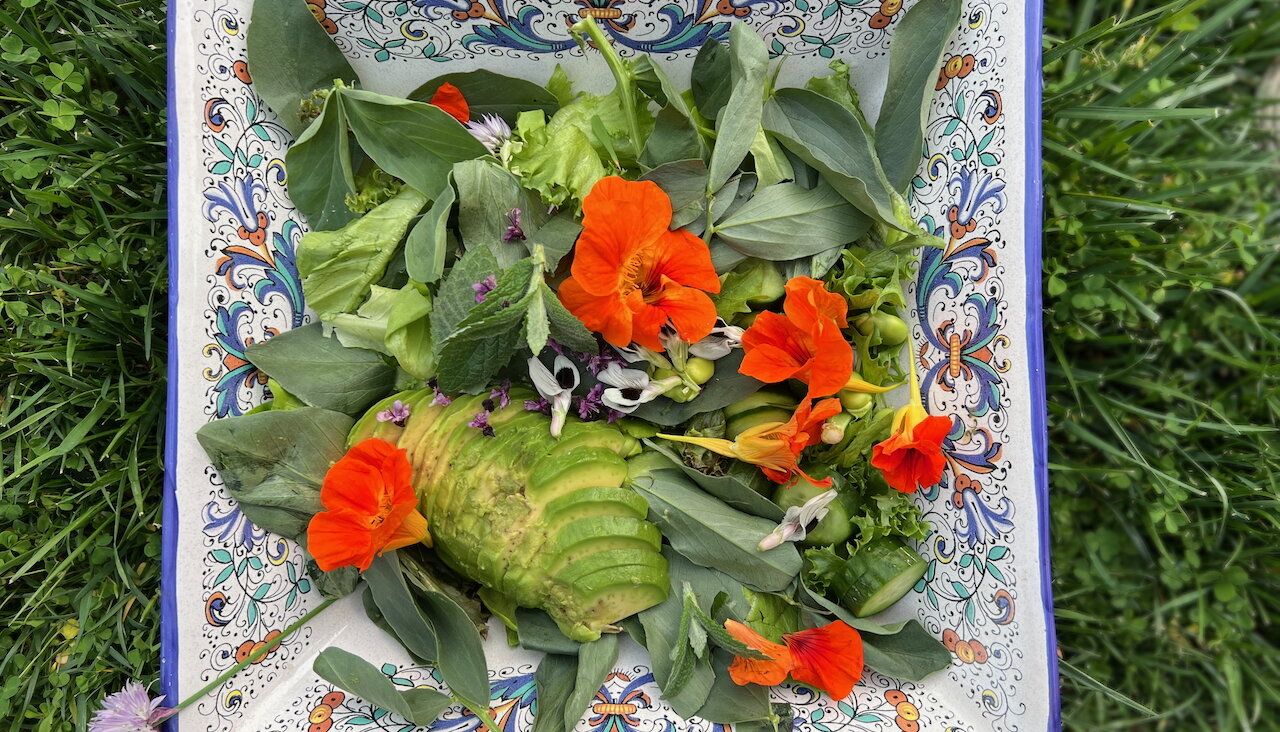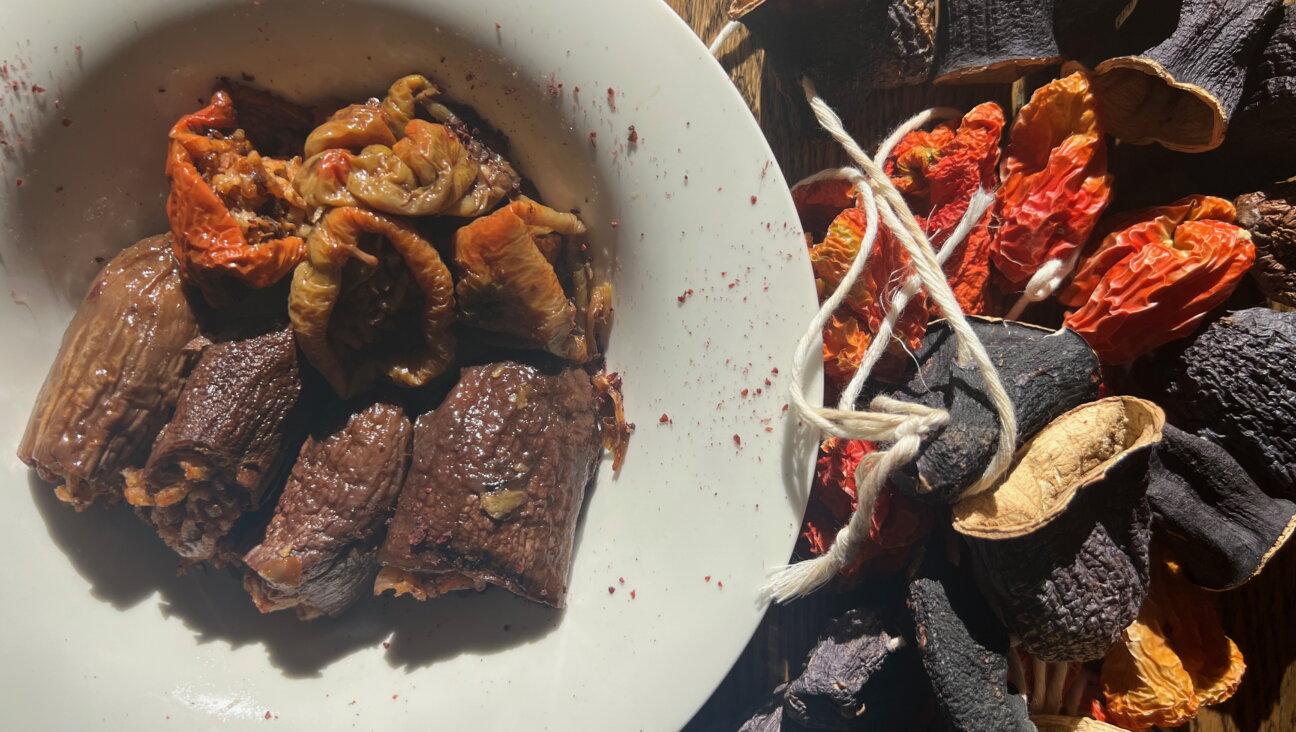Hot Moroccan harira soup beats cold fish for Yom Kippur break fast

Over 300 hungry Nashuva congregants gather for breakfast harira, 2019. Image by @foodaism

Julie Drucker adds orange lentils to the harira pot Image by @foodaism
Among the many beloved traditions the pandemic has derailed is one that is only a year old: making and serving a Yom Kippur break-the-fast soup to 300 very hungry people.
The soup is Morrocan harira, the traditional dish Sephardic Jews, especially those from North Africa, eat at the end of the Yom Kippur fast.
Harira is stew-like, with onions, tomato, rice, lentils, cumin and chile, then finished with lemon juice, parsley and dill. The toasted spices and herbs work like smelling salts, sna;ping you back to earth. The lentils quickly fill you up without weighing you down. The touch of hot chile pepper jumpstarts your appetite.
For Askenazi Jews, like me, the meal that marks the end of the holiday of atonement and repentence can be a little punitive itself. The light, healthy being inside you suddenly confronts a groaning board of salty lox, gummy cream cheese, oily whitefish, the egg- and sugar-packed baked noodle pudding called kugel, and of course bagels, piles and piles of bagels. Bagels stacked up like barbell weights, bagels that will set anchor in your stomach until the next High Holy Day.
Ashkenazi Jews settled in Central Eastern Europe around the end of the first millennium. Their foods are the foods of their neighbors: bagels, lox, cream cheese, noodle pudding, or kugel, pastrami, corned beef, borscht. When you think deli, think Ashkenazi.
Sephardic Jews took a different route, settling in Spain—the Hebrew word is Sepharad—then fanning out to Portugal, North Africa and the Levant. The foods they adopted or adapted include hummus, couscous, harissa and tagines.
Sephardic cuisine reflects the Mediterranean diet. Meanwhile, no one has written The Ashkenazi Diet. I suppose it’s possible to slim down on nothing but gefilte fish and cheese blintzes, you’d just have to schedule in four hours of Lagree Pilates, twice each day.
I enjoy Sunday morning lox, but at the end of Yom Kippur, I go full Sephardic.
This recipe comes from Meme Suissa, a generous and specatcular Moroccan cook, the mother of my former colleague David Suissa. She learned to make harira from her grandmother and mother in Casablanca. Years ago, I spent an afternoon at David’s house while Meme walked me through the steps. The recipe came with reminiscences about how the soup was something the Jews and Muslims shared — the Muslims made it for Ramadan, the Jews for Yom Kippur, and they would often trade recipes and tastes. The idea that a soup could be the bridge between Jews, Muslims and their most sacred holiday makes it that much more special.
Over the past two years, I’ve made a slightly adapted version of Meme’s recipe for my community, Nashuva. My wife, Rabbi Naomi Levy, leads High Holiday services for Nashuva, the congregation she founded. One night, I suggested to her that instead of offering just the standard Ashkenazi fare for a communal breakfast, we add harira.
Naomi announced it to her congregation of 1200 souls. Soup was on.
I combined Meme’s recipe with inspirations from other cooks and sites, including David Tanis and TasteofMaroc.com. To cook for a village, it takes a village.
I bought a 15-gallon soup pot from Smart and Final, two feet tall by 1 1/2 feet in diameter. Our friend Julie Drucker came over, along with my mother Sari, and we chopped and sautéed 30 onions, added 120 cups of diced tomato, 30 cinnamon sticks, 20 cups of lentils, 120 garlic cloves — you get the idea. I figured just 300 people would stay for the breakfast, but that was 300 people who hadn’t eaten in 25 hours.
This year, there will be virtual services and no harira — thanks pandemic. But the recipe I scaled up to 300 easily scales down to serve 10, which will allow for leftovers.
Next year, let’s all pray for soup.
Harira for a crowd

Over 300 hungry Nashuva congregants gather for breakfast harira, 2019. Image by @foodaism
This recipe serves 20. It can easily be divided or multiplied. (For Nashuva, I multiplied it 15 times). This version is vegan, though you could replace the water with chicken stock, or even add shreds of cooked chicken, as Meme Suissa does.
2 large onions, finely diced, about 4 cups
2 cups diced celery and celery leaves
½ cup olive oil plus more for garnish
8 garlic cloves, minced
2 tablespoon dried ginger
3 teaspoons black pepper
4 teaspoons turmeric
2 teaspoon toasted and ground cumin
1-2 teaspoons dried red chile flakes
2 (3-inch) piece cinnamon stick, ground, or 1/4 teaspoon ground cinnamon
8 cups diced ripe tomato, fresh or canned
2 T. tomato paste
Salt
4 cup red lentils, rinsed
2 cup dried chickpeas, soaked overnight
Either 1/2 pound angel hair pasta or vermicelli, broken into 1-inch pieces or 6 T. uncooked white rice
Serving Garnishes:
Lemon wedges, EVOO olive oil, chopped parsley, chopped cilantro, chopped fresh dill, harissa PREPARATION
Heat olive oil in a large heavy-bottomed soup pot. Saute onion and celery until softened, about 20 minutes. Add garlic, ginger, pepper, turmeric, cumin, red pepper flakes and cinnamon. Cook until the spices smell fragrant, about 3 minutes.
Add tomato and tomato paste and bring the mixture to a simmer. Cook, stirring until mixture thickens somewhat, then add 2 1/2 teaspoons salt, lentils and garbanzos. Add 16 cups of water.
Bring to a boil, then partially cover and lower to a simmer.
After one hour, taste for salt, pepper and other spices. Add rice. Cook for another hour, adding more water to keep the consistency like cream. The beans should be very soft.
Serve, and encourage your guests to garnish the soup with lemon, herbs, harissa and olive oil.
This recipe and a different version of this story originally appeared on Foodaism.com.

Harira for 300 Image by @foodaism
The Forward is free to read, but it isn’t free to produce

I hope you appreciated this article. Before you go, I’d like to ask you to please support the Forward.
Now more than ever, American Jews need independent news they can trust, with reporting driven by truth, not ideology. We serve you, not any ideological agenda.
At a time when other newsrooms are closing or cutting back, the Forward has removed its paywall and invested additional resources to report on the ground from Israel and around the U.S. on the impact of the war, rising antisemitism and polarized discourse.
This is a great time to support independent Jewish journalism you rely on. Make a gift today!
— Rachel Fishman Feddersen, Publisher and CEO
Support our mission to tell the Jewish story fully and fairly.
Most Popular
- 1

Fast Forward Ye debuts ‘Heil Hitler’ music video that includes a sample of a Hitler speech
- 2

Opinion It looks like Israel totally underestimated Trump
- 3

Culture Cardinals are Catholic, not Jewish — so why do they all wear yarmulkes?
- 4

Fast Forward Student suspended for ‘F— the Jews’ video defends himself on antisemitic podcast
In Case You Missed It
-

Culture Should Diaspora Jews be buried in Israel? A rabbi responds
-

Fast Forward In first Sunday address, Pope Leo XIV calls for ceasefire in Gaza, release of hostages
-

Fast Forward Huckabee denies rift between Netanyahu and Trump as US actions in Middle East appear to leave out Israel
-

Fast Forward Federal security grants to synagogues are resuming after two-month Trump freeze
-
Shop the Forward Store
100% of profits support our journalism
Republish This Story
Please read before republishing
We’re happy to make this story available to republish for free, unless it originated with JTA, Haaretz or another publication (as indicated on the article) and as long as you follow our guidelines.
You must comply with the following:
- Credit the Forward
- Retain our pixel
- Preserve our canonical link in Google search
- Add a noindex tag in Google search
See our full guidelines for more information, and this guide for detail about canonical URLs.
To republish, copy the HTML by clicking on the yellow button to the right; it includes our tracking pixel, all paragraph styles and hyperlinks, the author byline and credit to the Forward. It does not include images; to avoid copyright violations, you must add them manually, following our guidelines. Please email us at [email protected], subject line “republish,” with any questions or to let us know what stories you’re picking up.
















